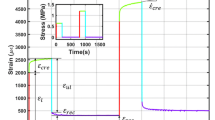Summary
A conceptual framework is presented for understanding and investigating structural adaptation of cortical bone. The magnitudes, orientations, and sense (tension or compression) of the physiologically incurred cyclic principal strains vary markedly throughout the skeleton. It is probable, therefore, that the strain/remodeling response of bone is site specific. Furthermore, there is some indication that immature bone is more responsive to alterations of cyclic strains than mature bone. Animal experimental studies and complementary stress and strain analyses suggest that the structural adaptation due to changes in cyclic strain fields may be a very nonlinear response. Bone loss in mature animals due to immobilization is sensitive to even small changes in the cyclic bone strains. Under normal conditions, however, there appears to be a broad range of physical activity in which bone is relatively unresponsive to changes in loading history. With severe repeated loading, bone hypertrophy can be pronounced. These observations open the possibility that bone atrophy and hypertrophy are controlled by different mechanisms. Therefore, two (or more) complementary control systems may be involved in the regulation of bone mass by bone cyclic strain histories. It is probable that bone mechanical microdamage is one control stimulus for affecting an increase in bone mass.
Similar content being viewed by others
References
Treharne RW (1981) Review of Wolff's Law and its proposed means of operation. Orthopaedic Review 10:35–47
Roesler H (1981) Some historical remarks on the theory of cancellous bone structure (Wolff's Law). In: Cowin SC (ed) Mechanical properties of bone. American Society of Mechanical Engineers Publication AMD-Vol 45:27–42
Wolff J (1982) Das gesetz der transformation der knochen. A. Hirshwald, Berlin
Currey JD (1983) Mechanical and biological requirements for structural competence in the skeleton (what should bones be designed to do?) Presented at Kroc Foundation Conference on Functional Adaptation in Bone Tissue, Santa Ynez Valley, CA, July 11–15
Carter DR (1982) The relationships betweenin vivo bone stresses and cortical bone remodeling. In: Bourne JR (ed) CRC Critical Reviews in Bioengineering, Boca Raton, FL, CRC Press, 8:1–28
Carter DR, Caler WE (1983) Cycle-dependent and time-dependent bone fracture with repeated loading. J Biomech Eng 105:166–170
Carter DR, Caler WE, Spengler DM, Frankel VH (1981) Fatigue behavior of adult cortical bone—the influence of mean strain and strain range. Acta Orthop Scand 52:481–490
Carter DR, Harris WH, Vasu R, Caler WE (1981) The mechanical and biological response of cortical bone to in vivo strain histories. In: Cowin SC (ed) Mechanical properties of bone. American Society of Mechanical Engineers Publication AMD-Vol 45-81-92
Rubin CT, Lanyon LE (1982) Limb mechanics as a function of speed and gait: a study of functional strains in the radius and tibia of horse and dog. J Exp Biol 101:187–211
Carter DR, Hayes WC (1977) Compact bone fatigue damage. I. Residual strength and stiffness. J Biomech 10:325–338
Chamay A, Tschantz P (1972) Mechanical influences in bone remodeling. Experimental research on Wolff's Law. J Biomech 5:173–180
Woo S.L-Y (1981) The relationships of changes in stress levels on long bone remodelling. In Cowin SC (ed) Mechanical properties of bone. American Society of Mechanical Engineers Publication AMD-Vol 45:107–129
Liskova M, Hert J (1971) Reaction of bone to mechanical stimuli. Folia Morphologica 19:301–317
Lanyon LE (1981) The measurement and biological significance of bone strain in vivo. In: Cowin SC (ed) Mechanical properties of bone. American Society of Mechanical Engineers Publication AMD-Vol 45:93–106
Churches AE, Howlett CR (1981) The response of mature cortical bone to time-varying loading. In: Cowin SC (ed) Mechanical properties of bone. American Society of Mechanical Engineers Publication AMD-Vol 45:69–80
Carter DR, Vasu R, Harris WH (1981) The plated canine femur—relationships between the changes in bone stresses and bone loss. Acta Orthop Scand 52:241–248
Gunst MA (1980) Interference with bone blood supply through plating of intact bone. In: Uhthoff HK (ed) Current concepts of internal fixation of fractures. Springer-Verlag, Berlin, pp 268–276
Carter DR, Vasu R, Spengler DM, Dueland RT (1981) Stress fields in the unplated and plated canine femur calculated from in vivo strain measurements. J Biomech 14:63–70
Author information
Authors and Affiliations
Additional information
Supported by NIH grants AM32377 and AM01163 (RCDA)
Rights and permissions
About this article
Cite this article
Carter, D.R. Mechanical loading histories and cortical bone remodeling. Calcif Tissue Int 36 (Suppl 1), S19–S24 (1984). https://doi.org/10.1007/BF02406129
Issue Date:
DOI: https://doi.org/10.1007/BF02406129




